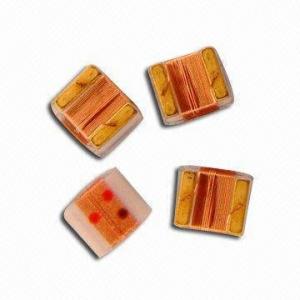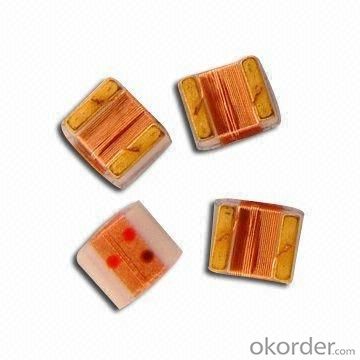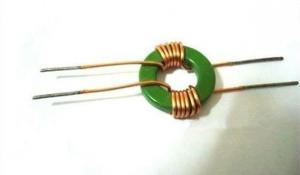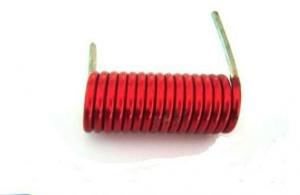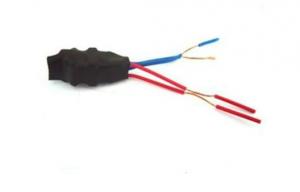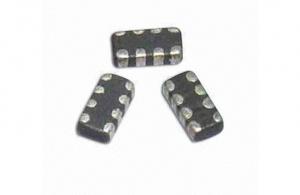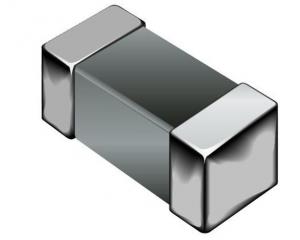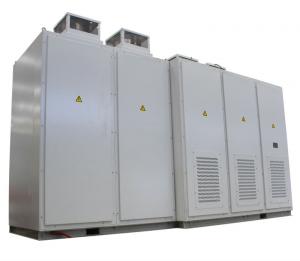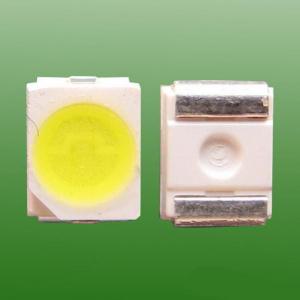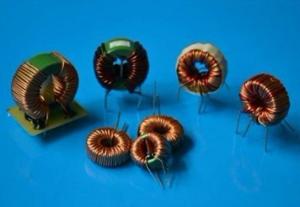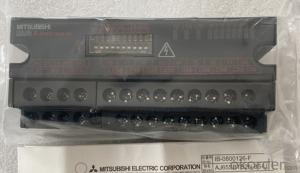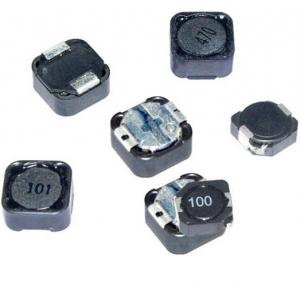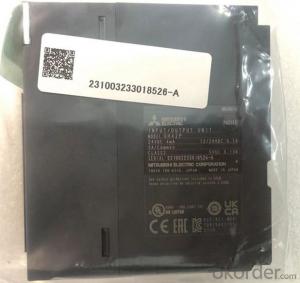SMD Multilayer Ferrite Chip Bead
- Loading Port:
- China Main Port
- Payment Terms:
- TT or LC
- Min Order Qty:
- 4000 Pieces pc
- Supply Capability:
- 4000 Pieces per Day pc/month
OKorder Service Pledge
OKorder Financial Service
You Might Also Like
low frequency Inductor/filter
1.SMD multilayer ferrite chip bead
2.Low Crosstalk/DCR Features
3.competitive price
4.by customer's requests
Features:
1.Low crosstalk/DCR, high reliability
2.Low crosstalk between adjacent circuits
3.Single MZA series chip provides noise attenuation for four lines, ideal for various highly miniaturized I/D lines
4.Internal electrodes feature low DC resistance, minimizing wasteful power consumption
5.Electroplated terminal electrodes accommodate flow and reflow soldering
6.Monolithic structure ensures high reliability
7.Operating temperature range: from -25 to 85 degree Celsius
Applications:
1.High-frequency noise counter measured in computer
2.Printers
3.Portable telephones and other equipments
4.VCRs
5.Televisions
- Q: A solenoid inductor carries a current of 180 mA. It has a magnetic flux of 19.0 mu Wb per turn and stores 1.40 mJ of energy.How many turns does the inductor have?
- the magnetic energy stored in inductor (L), having N turns, is E (mag) 0.5 L I^2 ----------------- given mag. flux with each turn [phi (1)] 19*10^-6 Weber/turn Total flux linked with L [phi (N)] 19*10^-6* N but total flux L I 19*10^-6* N L 19*10^-6* N / I E (mag) 0.5 [19*10^-6* N / I] I^2 E (mag) 0.5 *19*10^-6* N * I N 1.40*10^-3 /[0.5 *19*10^-6* 180*10^-3] N 818.7
- Q: How do I figure out inductor equivalence when you have a series parallel combination inductor circuit
- treat them as they where resistors sum them up when in series .parallel them when in parallel
- Q: I have been looking for a type of inductor or coil to pickup the magnetic flux lines from a pair of passing magnets to pass an electrical signal. I am not sure what type to use in this situation. any suggestions?thank you,Michael
- to be more specific, I am looking to make a generator setup that will use either wind or water. I am using magnets and coils to generate the electricity. asking for advice at to the best type of coil to use
- Q: a dc voltage source is connected to an inductor through a switch and then the switch is closed . at t 0 the inductor will behave as an open circuit . no current will flow and all the source voltage will be across the inductor. why is that? why the inductor has such behaviour. why no current can pass through the inductor at t0.
- At t0, switch closed and a potential came across the inductor. So it is like a Alternating current for a Moment. That alternating current makes inductor to behave like in AC circuit. That affects reduce continuously after t+ time because of dc voltage. There will a opposing electromagnetic field in the inductor due to sudden voltage. that will stop current to flow through the inductor
- Q: A 0.3268 mH inductor has a length that is four times its diameter.If it is wound with 11.8 cm?1 turns per centimeter, what is its length?Answer in units of m.
- If wire-wound with 11.8 turns/cm 11.8/0.01 1180 turns/m The inductance is given by; L ?o N? ? A ? 4d A ? π d? (1/64) π ?? L (4πx10^-7) (1800)π?? 0.3268x10-? ? ?√{(0.3268x10-?)/(0.0071) 0.358 m
- Q: A 1.15-?H inductor is connected in series with a variable capacitor in the tuning section of a short wave radio set. What capacitance tunes the circuit to the signal from a transmitter broadcasting at 6.84 MHz?_________pF
- f1/(2π√LC) , f6.84*10^6Hz , L1.15μH , C? √LC 1/2πf 1/2*3.14*6.84*10^6 2.3268*10^-8 LC 5.414*10^-16 C 5.414*10^-16/1.15*10^-6 470.78[pF]
- Q: A 26.0 mH inductor has a reactance of 1.80 k. (a) What is the frequency of the ac current that passes through the inductor? ____Hz(b) What is the capacitance of a capacitor that has the same reactance at this frequency? ___ F(c) The frequency is tripled, so that the reactances of the inductor and capacitor are no longer equal. What is the new reactance of the inductor?____ k(d) What is the new reactance of the capacitor?___ k
- The inductive reactance cannot be calculated without more information.
- Q: An inductor 2H is connected in series with a bulb with resistance 5ohms and 9v dc power supply and a time constant of 0.4sWhat is the voltage across the light bulb after 0.5s. ??
- Current (V/R)*(1 - e^(-t/T)) where t time, T time constant After 0.5 seconds I (9/5)*(1 - e^(-0.5/0.4)) Voltage current*resistance I*5 9*(1 - e^(-0.5/0.4)) Over to you and your calculator!
- Q: antenna ,is it act like an exitation source for loop antenna to generate oscillations.plz answer it
- An inductive coupling link/loop can be used with a loop antenna. This works in the same way as a transformer, with the inductive link as the primary (for transmitting), but at the particular radio frequency. A loop antenna often represents some sort of resonant circuit, and this can be combined with the inductive link coupling to match the antenna impedance to the transmission line and transmitter impedances. With other types of antenna an inductor and/or capacitor arrangement (an LC network) may be used for matching the antenna impedance to the lines. The actual values and conficuration depends on the specific antenna. For example, teh model of a vertical quarter wave antenna is a small capacitor in series with the radiation resistance. By adding a series inductor the capacitance can be made to resonate, maximising the current in the radiation resistance.
- Q: Do they have an ideal resistance of an open circuit or a closed circuit?
- An ideal inductor has 0 ohms of resistance. If you are finding an AC Thevenin equivalent, you must include the inductance.
1. Manufacturer Overview
| Location | Guangdong,China (Mainland) |
| Year Established | 2010 |
| Annual Output Value | US$10 Million - US$50 Million |
| Main Markets | North America; South America; Eastern Europe; Southeast Asia; Africa; Oceania; Mid East; Eastern Asia; Western Europe |
| Company Certifications | ISO 9001:2000 |
2. Manufacturer Certificates
| a) Certification Name | |
| Range | |
| Reference | |
| Validity Period |
3. Manufacturer Capability
| a) Trade Capacity | |
| Nearest Port | |
| Export Percentage | 41% - 50% |
| No.of Employees in Trade Department | |
| Language Spoken: | |
| b) Factory Information | |
| Factory Size: | |
| No. of Production Lines | |
| Contract Manufacturing | OEM Service Offered Design Service Offered Buyer Label Offered |
| Product Price Range | |
Send your message to us
SMD Multilayer Ferrite Chip Bead
- Loading Port:
- China Main Port
- Payment Terms:
- TT or LC
- Min Order Qty:
- 4000 Pieces pc
- Supply Capability:
- 4000 Pieces per Day pc/month
OKorder Service Pledge
OKorder Financial Service
Similar products
Hot products
Hot Searches
Related keywords
